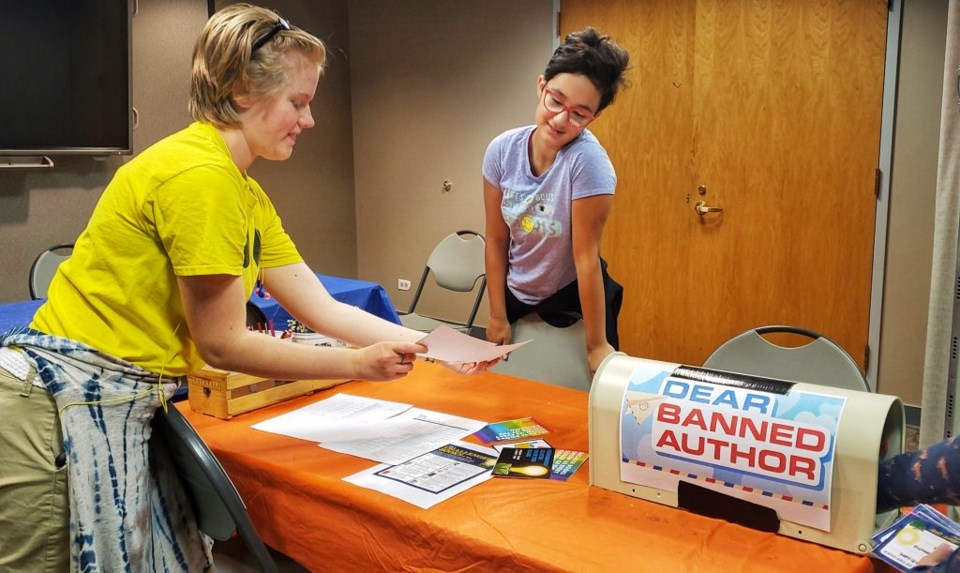This content was originally published by the Longmont Observer and is licensed under a Creative Commons license.
Teens had a lively discussion about book banning while having pizza and writing to banned authors during the Teen Banned Books Party held Monday, September 23, at the Longmont Library. The party was held in partnership with nationwide Banned Books Week programs held each year.
The event's mission was to keep teens and tweens informed about censorship attempts.
As an effort to draw awareness to the public about the dangers of censorship, access to free and open information, the maintenance of Intellectual Freedom, and the freedom to read, Banned Books Week has been put on through the American Library Association since 1982.
According to Banned Books Week Organization, this year's list included eleven titles on its most challenged books, instead of ten. The list includes titles like the Captain Underpants series by Dav Pilkey, for "encouraging disruptive behavior," The Hate U Give by Angie Thomas for being "anti-cop," and Drama by Raina Telgemeier, for including LGBTQIA themes.
"Many of the frequently challenged books have LBGTQ characters in them. We think it's it really important to convey to our teens that this form of censorship and demeaning groups of people is dangerous," says librarian Claire Studholme.
Seeking a new approach the Longmont Library created a social event to educate teens about banned books. Part of the event included understanding how today's teens feel about book banning and intellectual freedom.
Teen participants watched a short video presentation, which offered statistics on who initiates challenges and where the challenges take place. Attendees were asked to discuss the topic and think of ways to combat censorship. Topics like context and having an informed public were named as ways to bring challenged numbers down.
The group discussed terms like "soft censorship," which is the act of not putting a book or material out into the public at all. Acts of soft censorship could be hiding a book behind a desk, making the book hard to find, or making excuses for not having it available. This is usually done by employees of schools or libraries who want to avoid controversy, explained Studholme.

"People think our age makes us ignorant," said Clare Bolon, a teen reader who attended the event. She is reading Pride and Prejudice by Jane Austen, which she sees as a lesson on class structure. Bolon was joined by several young readers who expressed how important books are for educating their age group on issues many adults don't know how to address.
There was a plethora of information for attendees to digest. According to the American Library Association, 59% of challenges take place in public libraries, and 23% in school libraries. Patrons were most likely to initiate a challenge - at 33%, while parents comprised 32% of initiators.
Reasons for book challenges include "satanism," "smoking," "liberal propaganda," "teen suicide," and "anti-cop" themes as listed in the ALA's website. It's Office for Intellectual Freedom tracked 347 challenges in 2018. Not all of them were for books. Challenges were also brought against displays, art, programs, meetings, magazines, and film. The ALA also "noticed an increase in attempts to censor drag queen story hours and LGBTQIA programming," according to their website.
"As a public library our mission is to ensure our community has open, free, and equitable access to information for enjoyment, education, and otherwise," states Studholme. "This week and this program specifically opens up dialogue on the subject and an opportunity to continue to ensure that the Library continues to be a place where all sorts of books are available and that individuals and their families get to decide what is 'appropriate' or 'not appropriate for folks to be reading, not outside forces."
Studholme explains that the library wants to actively include all people and all stories at the library. She wants to recognize "our diversity of experiences, backgrounds, languages, and culture."
"Occasionally, library staff particularly in the Children's and Teen area, will get concern from parents about certain topics and books that we have on our shelves. We often explain that is the responsibility of the parent to determine what is appropriate, not the Library's. We can provide general guidance on reading level and overall target age group for books and share what the content is about. Our role is to provide a wide array of options," Studholme says.


